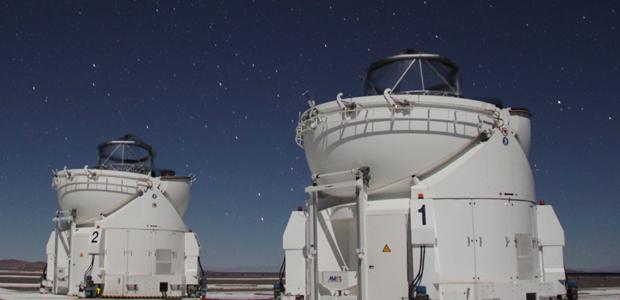Desert in Chile is Future Site of Extremely Large Telescope
The Very Large Telescope at night at the Paranal Observatory, Antofagasta, Chile. (Photo: Steven Bodzin)
For the Geo Quiz, we are looking for a desert where the sophisticated telescopes at the Paranal Observatory are located. The vast desert stretches out 600 miles along Chile’s Pacific Coast and is said to be the driest desert in the world.
It is a place where international astronomers come and go as the research observatories allow scientists to see into the far reaches of the universe.
The Atacama Desert is the answer to the Geo Quiz. It is the future site of the Extremely Large Telescope, the world’s first 40 meter optical telescope.
It is a remote location south of the city of Antofagasta and next door to the existing Paranal, Observatory. Reporter Steven Bodzin paid a visit and shares his experience.
The European Southern Observatory, a coalition of 15 European countries, in June decided to build the world’s biggest optical telescope at Cerro Armazones in Chile. The new telescope, with its mirror the size of a baseball infield, will be able to collect millions of times more light than the naked eye. Combine that with long exposures and advanced methods of eliminating atmospheric distortion, and this telescope will be able to see, for example, individual planets orbiting other stars.
“We’ll be for the first time able to look around a star,” says Massimo Tarenghi, representative of the ESO in Chile. “That means to see planets, rotating around other stars.” It will be possible, he says, to detect the composition of these planets’ atmospheres.
Cerro Armazones is not a new site for a telescope. It is within view of the Paranal Observatory, a campus deep in Chile’s Atacama Desert. The site is about two hours by paved road south of the city of Antofagasta.
Paranal feels like a Mars colony. To enter its living quarters and dining hall, one must walk down a ramp into the red, rocky ground. There, under a glass dome, is a tiny oasis, its lush tropical garden soothing the eyes after hours of dazzling sun and landscapes devoid of any plant life. At night, the dome and the rest of the site’s windows are covered in blackout curtains to keep the sky dark for astronomy. Cars on the campus drive with their headlights off.
Paranal’s telescopes are atop an adjacent mountain. There are four dome-topped, robotic telescopes that move themselves around to form the best configuration for jointly observing distant light sources. Next to them are four metal silos. In each is a powerful telescope with an 8.2-meter mirror. There are bigger mirrors at other sites, but these telescopes– jointly known as the Very Large Telescope – are able to work together. They send light through underground tunnels to be aligned to the nanometer and observed as though the four were a single unit.
Each of the 8.2 meter telescopes is a huge machine. The 100-ton mirror assemblies sit atop turntables so balanced that two people can rotate them by hand. The silos hum with refrigeration equipment and pulsing liquid nitrogen pumps, because the super-sensitive digital cameras that receive light from the mirrors need to be kept cold.
The mirrors are heavy, so when they are tilted to observe one distant object or another, they lose their shape. A set of pistons under the mirrors pushes them back into perfect parabolas.
In addition, the most advanced instruments are able to eliminate atmospheric distortion. The telescope monitors a single bright object to constantly detect how the atmosphere is distorting light – what we normally see as twinkle in the stars. It uses a high-speed system to correct incoming light.
“It sends a signal to a wobbly, deformable mirror, that is a few centimeters across, and that mirror compensates for that change,” says George Hau, an astronomer with the ESO, as he shows guests around the site. “And that’s done several hundred times a second. And so the light bouncing off that mirror will be perfect, or near perfect.”
The whole system is run from a control room just below the telescopes. There, scientists work from dusk to dawn, collecting observations of distant stars, planets, galaxies, clusters – even clouds of dust near the dark objects that are most likely black holes.
In one corner of the control room, there is an area already set aside as the place where the new 40-meter telescope will be run. That machine, called the Extremely Large Telescope, will take 10 years and more than a billion euros ($1.2 billion) before it offers up new views of the sky.
